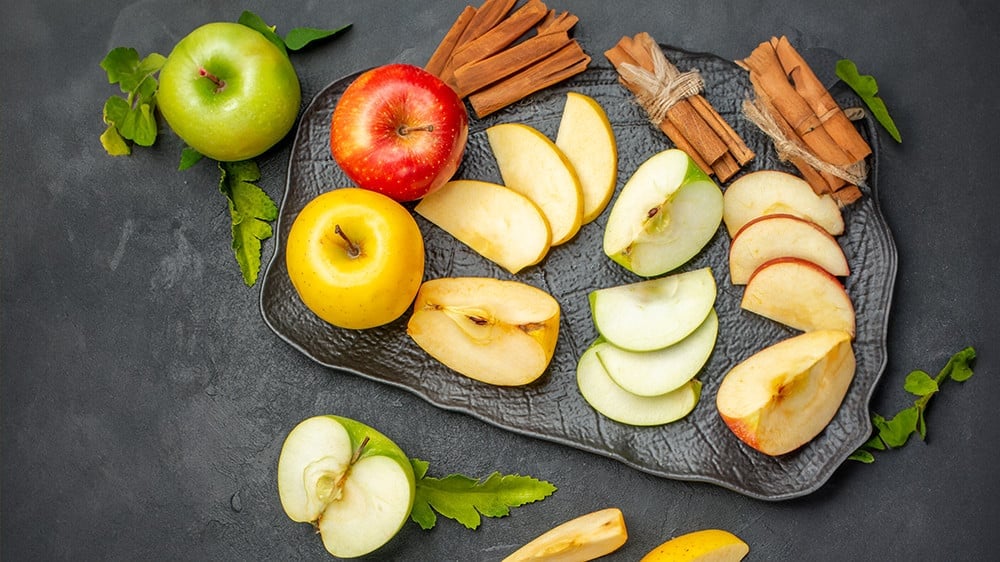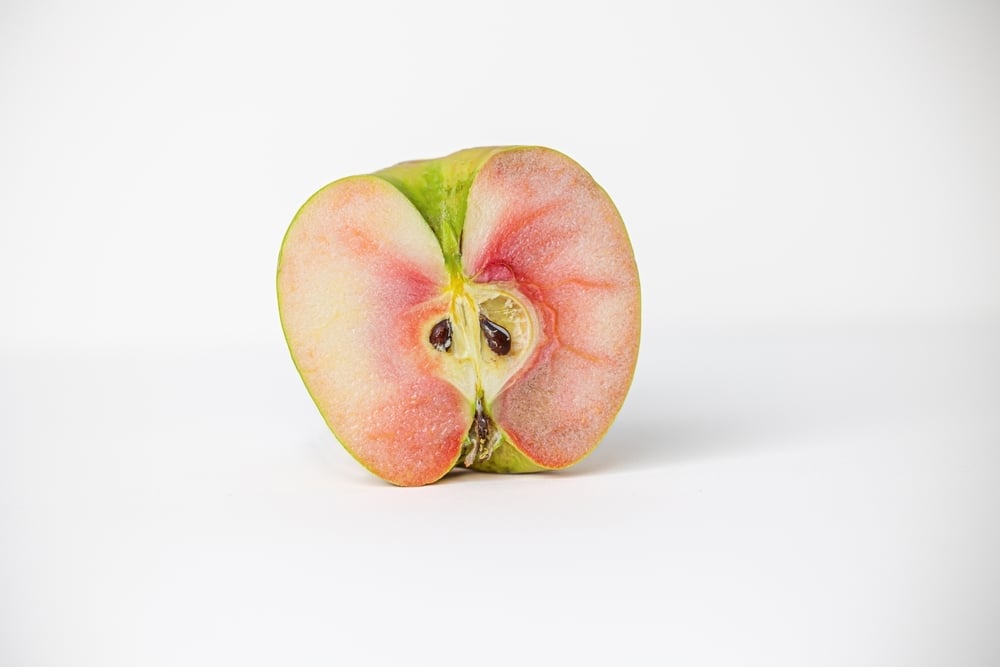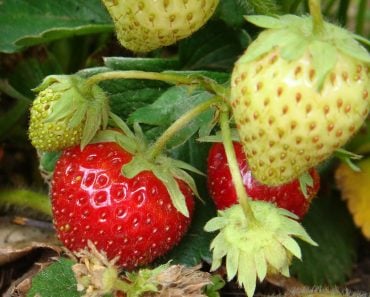Table of Contents (click to expand)
Apples are among the most widely produced and consumed fruits in the world. Breeders are now trying to get the red pigment, anthocyanin, which gives the peel its red color, into the flesh of the fruit itself.
Apples are the third most produced fruit in the world after bananas and watermelons. In 2021, over 93 million metric tons of apples were produced globally. That is a lot of apples.
Cultivated apples (Malus domestica Borkh.) belong to the family Rosaceae. The genus Malus includes 30-35 species of smaller fruited varieties called crab apples, which are mostly used as ornamental plants. Apple breeders often use crab apples to introduce important traits, such as disease resistance or shorter juvenility, into cultivated types.
Apples are a rich source of polyphenols (typically 110 mg/100 g) and studies have shown that apples have anti-inflammatory, anticancer, and antioxidant effects, along with helping those who suffer from cardiovascular issues. Among the polyphenols are anthocyanins, which give the apple peel its red color.

Recommended Video for you:
The Red Color Makes Apples Healthy
Apples are usually red, green, or yellow on the surface with white flesh beneath. The apple peel gets its red color from anthocyanin.
Anthocyanins are water-soluble plant pigments that give color to many red fruits, including cherries and grapes. Anthocyanins are polyphenolic antioxidants and an important type of flavonoids found in plants.
In white-fleshed apples, most of the anthocyanins are concentrated in the red peel. However, we eat very little of the peel. Red fleshed apples, on the other hand, would be a much richer source of phenolics and flavonoids, which might help boost an apple’s health benefits.
However, developing a red-fleshed apple isn’t as easy as “adding a molecule into the flesh”.
Fruit color depends on the genetics of the variety, plant hormones, and the environment (temperature and light). Anthocyanins, in particular, depends on the pH of plant cells. This why we see different colors in roots, leaves, stems, flowers, and fruits.
Researchers and breeders spend a considerable amount of time studying fruit color development.
Can Apples Have Red Flesh?
You can find red-fleshed apples among crab apples and some older apple varieties. Anthocyanins are a large family of chemicals. The red color of apples comes from an anthocyanin called cyanidin 3-galactoside found in the flesh.
Looking at the plant’s DNA, segments of the DNA called MYB transcription factors play a critical role in regulating anthocyanin production in the red skins. Transcription factors are proteins that turn genes on or off, and thus control the activity of the gene.
Two genes, MdMYB10 and MdNAC1 have been identified in red-flesh apples. Both of these genes are positive regulators of anthocyanin biosynthesis. This means that these genes ‘turn on’ the production of anthocyanins, thus resulting in the red color of the flesh.
Studies show that a duplication in an apple MYB transcription factor gene resulted in the red flesh color. Based on this, red-fleshed apples are categorized into two types: Type 1 is associated with a mutation in the MdMYB10 gene, which makes the fruit skin, flesh, leaves and all other vegetative tissues red; Type 2 is associated with the gene MdMYB110a. In Type 2, only the flesh is red, while the vegetative tissues do not have the red color.

Will You Find A Red-fleshed Apple In A Supermarket Near You?
If you go to your neighborhood supermarket, you will most likely not find a red-fleshed apple. This is because red-fleshed apple varieties have been commercialized only recently and only in a few parts of the world. Developing a new apple variety is a long-term project. It can take 20-30 years from the time the breeders start working on the variety to the time it is fully commercialized. However, there are a few commercialized red-flesh varieties, and a few more in the pipeline.
Malus sieversii f. niedzwetzkyana, the red-fleshed version of Malus sieversii (an ancestor of cultivated apples) is a rich source of polyphenols and flavonoids. Breeders in China are working on developing red-fleshed varieties by crossing M. sieversii f. niedzwetzkyana with popular varieties like Fuji and Gala.
Some older red-fleshed varieties are grown locally in certain parts of the world. For example, Mountain Rose apples can only be found in the Pacific Northwest of the US. Niedswetzkyana, Almata and Rubaiyat apples can be found in Kazakhstan, Kyrgyzstan, and Central Asia. Hidden Red Rose, formerly known as Arlie Red Flesh, was discovered in the 1960s in Oregon, USA. It was formally launched as a variety by Thomas Paine farms in 2001.
Newer Varieties
The Bavarian Fruit Center in Germany developed the variety Baya® Marisa, which is a cross between a red-fleshed tart variety and a sweet dessert apple. They also developed the variety Baya® Franconia, which has ‘two-tone flesh’ with a ring of red color surrounding the white core.

The Plant and Food research organization in New Zealand has developed a hybrid variety from red-fleshed and white-fleshed apples. However, this variety has yet to be commercialized.
Markus Kobelt in Switzerland developed a range of red-fleshed varieties named Redlove. These varieties were developed by crossing Royal Gala and Braeburn varieties with an undisclosed red-fleshed variety. They were released in 2010 and include the varieties Era, Calypso, Circe, Odysso, and Lollipop. Red Love is marketed by a British nursery and is grown in Europe, the USA, and Australia.
Probably one of the most famous red-fleshed apples is the Lucy Red, which was developed by a breeder from the US named Bill Howell. It is a cross between Honeycrisp and Arlie Red varieties. Lucy Red comes in two forms: Lucy Rose and Lucy Glo. Lucy Rose is red outside and inside, while Lucy Glo has yellow skin. The variety was launched in 2020 and is marketed by Chelan Fresh. Currently, it is grown mostly in Washington, USA.
Most recently, Montague, an apple grower in Australia, introduced a red-flesh apple variety called Kissabel. The variety was developed in France and is a cross between a white-fleshed cultivated apple and a red-fleshed crab apple.

Conclusion
Red-fleshed crab apples and a few lesser-known varieties have existed for a few decades. However, they have gained popularity only in recent years. Apple breeders around the world are working on developing red-fleshed apple varieties that will have the same crispiness, juiciness and other elite traits of major commercial varieties. Since apples are a tree fruit, it takes decades for a new variety to be developed and commercialized. In recent years, a few red-fleshed varieties have been commercialized. It remains to be seen if they gain the same level of popularity as the white-fleshed apples we have all come to love!
References (click to expand)
- Liu, W., Mei, Z., Yu, L., Gu, T., Li, Z., Zou, Q., … Wang, N. (2023, March 15). The ABA-induced NAC transcription factor MdNAC1 interacts with a bZIP-type transcription factor to promote anthocyanin synthesis in red-fleshed apples. Horticulture Research. Oxford University Press (OUP).
- Chen, Z., Yu, L., Liu, W., Zhang, J., Wang, N., & Chen, X. (2021, May). Research progress of fruit color development in apple (Malus domestica Borkh.). Plant Physiology and Biochemistry. Elsevier BV.
- Koutsos, A., Riccadonna, S., Ulaszewska, M. M., Franceschi, P., Trošt, K., Galvin, A., … Lovegrove, J. A. (2020, February). Two apples a day lower serum cholesterol and improve cardiometabolic biomarkers in mildly hypercholesterolemic adults: a randomized, controlled, crossover trial. The American Journal of Clinical Nutrition. Elsevier BV.
- Li, C. X., Zhao, X. H., Zuo, W. F., Zhang, T. L., Zhang, Z. Y., & Chen, X. S. (2020, February 16). Phytochemical profiles, antioxidant, and antiproliferative activities of four red‐fleshed apple varieties in China. Journal of Food Science. Wiley.
- Jezek, M., Zörb, C., Merkt, N., & Geilfus, C.-M. (2018, January 19). Anthocyanin Management in Fruits by Fertilization. Journal of Agricultural and Food Chemistry. American Chemical Society (ACS).
- Würdig, J., Flachowsky, H., Höfer, M., Peil, A., Eldin Ali, M. A. M. S., & Hanke, M.-V. (2014, July). Phenotypic and genetic analysis of the German Malus Germplasm Collection in terms of type 1 and type 2 red-fleshed apples. Gene. Elsevier BV.
- Red-fleshed: The science behind an uncommon apple breed.













